Foreword / YouTube Video Review
This pair of speakers was loaned to me by Mesanovic directly for review. I was not paid or compensated in any capacity for this review.
All my reviews are done on my own time with great care to give you all the best set of data and information I can provide in order to help you make a well-informed purchase decision. I offer this for free to all who are interested. In return, if you want to support this site please see the bottom of this review for ways you can help. It is greatly appreciated.
The review on this website is a brief overview and summary of the objective performance of this speaker. It is not intended to be a deep dive. Moreso, this is information for those who prefer “just the facts” and prefer to have the data without the filler. The video below has more discussion with respect to the technical merits and subjective notes I had during my listening sessions.
< coming eventually >
Information and Photos
Some specs from the manufacturer can be found here. Key features from the manufacturer are noted below.
- Frequency Response: 40Hz-20kHz +/- 1.0dB; -3dB @ 36Hz
- Crossover Frequencies: 150Hz & 2300Hz
- Drivers:
- High: 1” aluminum dome waveguide tweeter
- Mid: 5” aluminum cone woofer
- Low: 2 x 6.5” paper Kevlar subwoofers
- Amplification:
- Class D
- High: 150W
- Mid: 150W
- Low: 300W
- Connections: Balanced XLR Input, WiSA Wireless, Auto switching 115/230V
- Cabinet:
- Height: 15”
- Width: 8”
- Length: 14”
- Weight: 32 lbs
- Optional Mounting: VESA 100mm pattern on speaker rear
- Standby Mode: The speaker will enter a standby mode if no audio signal is detected for 20 minutes.
As of this writeup, the price per pair is approximately $5298 USD.
CTA-2034 (SPINORAMA) and Accompanying Data
All data collected using Klippel’s Near-Field Scanner. The Near-Field-Scanner 3D (NFS) offers a fully automated acoustic measurement of direct sound radiated from the source under test. The radiated sound is determined in any desired distance and angle in the 3D space outside the scanning surface. Directivity, sound power, SPL response and many more key figures are obtained for any kind of loudspeaker and audio system in near field applications (e.g. studio monitors, mobile devices) as well as far field applications (e.g. professional audio systems). Utilizing a minimum of measurement points, a comprehensive data set is generated containing the loudspeaker’s high resolution, free field sound radiation in the near and far field. For a detailed explanation of how the NFS works and the science behind it, please watch the below discussion with designer Christian Bellmann:
Measurements are provided in a format in accordance with the Standard Method of Measurement for In-Home Loudspeakers (ANSI/CTA-2034-A R-2020). For more information, please see this link.
The reference plane is at the midway point between the tweeter and midwoofer. The CDM65 has (2) options for tuning: Standard and Cardioid. I tested both configurations but due to similarity between different data sets I may not provide the results of both for a particular test; please see graphic headers for exact test condition.
CTA-2034 / SPINORAMA:
The On-axis Frequency Response (0°) is the universal starting point and in many situations it is a fair representation of the first sound to arrive at a listener’s ears.
The Listening Window is a spatial average of the nine amplitude responses in the ±10º vertical and ±30º horizontal angular range. This encompasses those listeners who sit within a typical home theater audience, as well as those who disregard the normal rules when listening alone.
The Early Reflections curve is an estimate of all single-bounce, first-reflections, in a typical listening room.
Sound Power represents all of the sounds arriving at the listening position after any number of reflections from any direction. It is the weighted rms average of all 70 measurements, with individual measurements weighted according to the portion of the spherical surface that they represent.
Sound Power Directivity Index (SPDI): In this standard the SPDI is defined as the difference between the listening window curve and the sound power curve.
Early Reflections Directivity Index (EPDI): is defined as the difference between the listening window curve and the early reflections curve. In small rooms, early reflections figure prominently in what is measured and heard in the room so this curve may provide insights into potential sound quality.
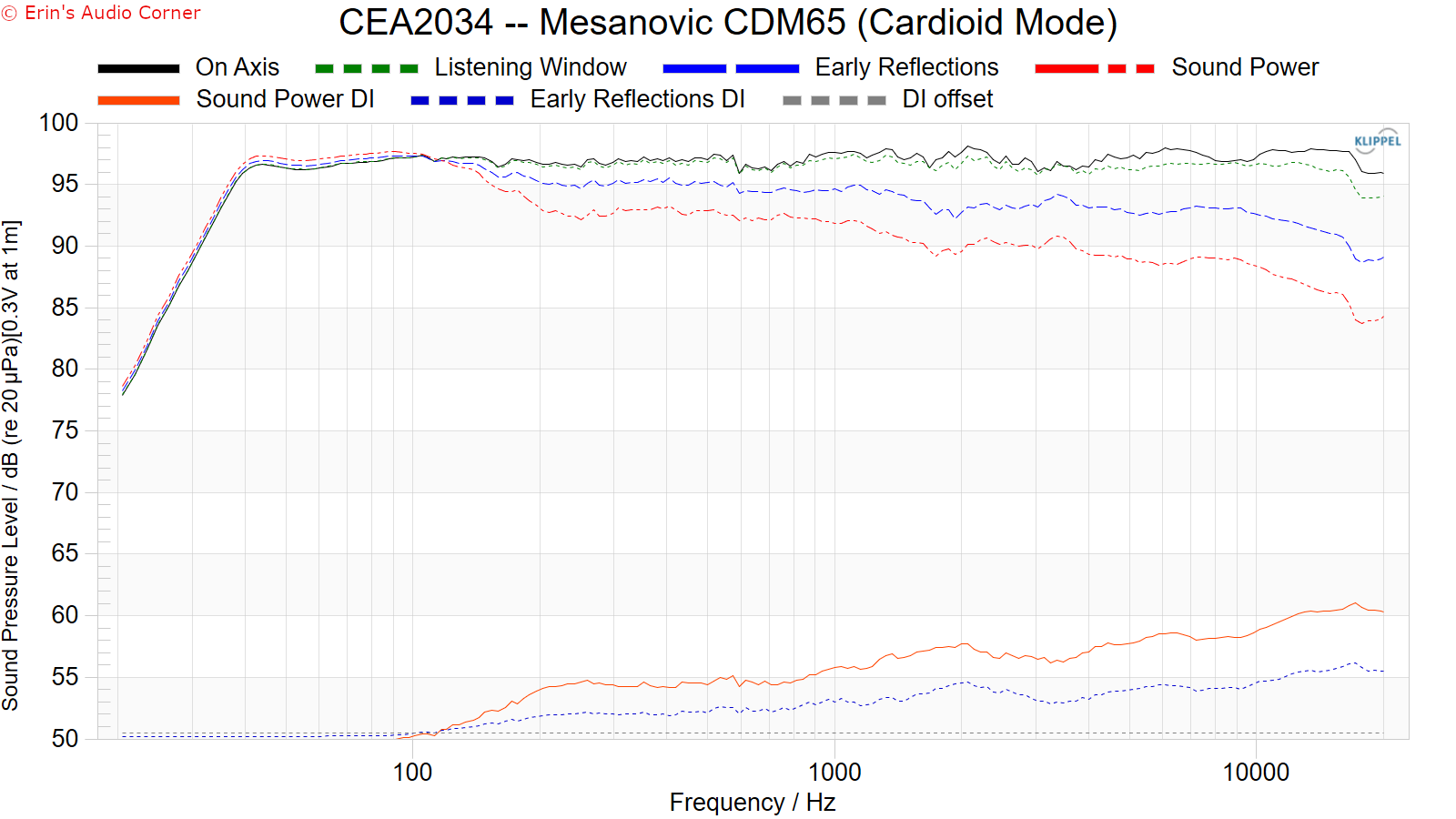
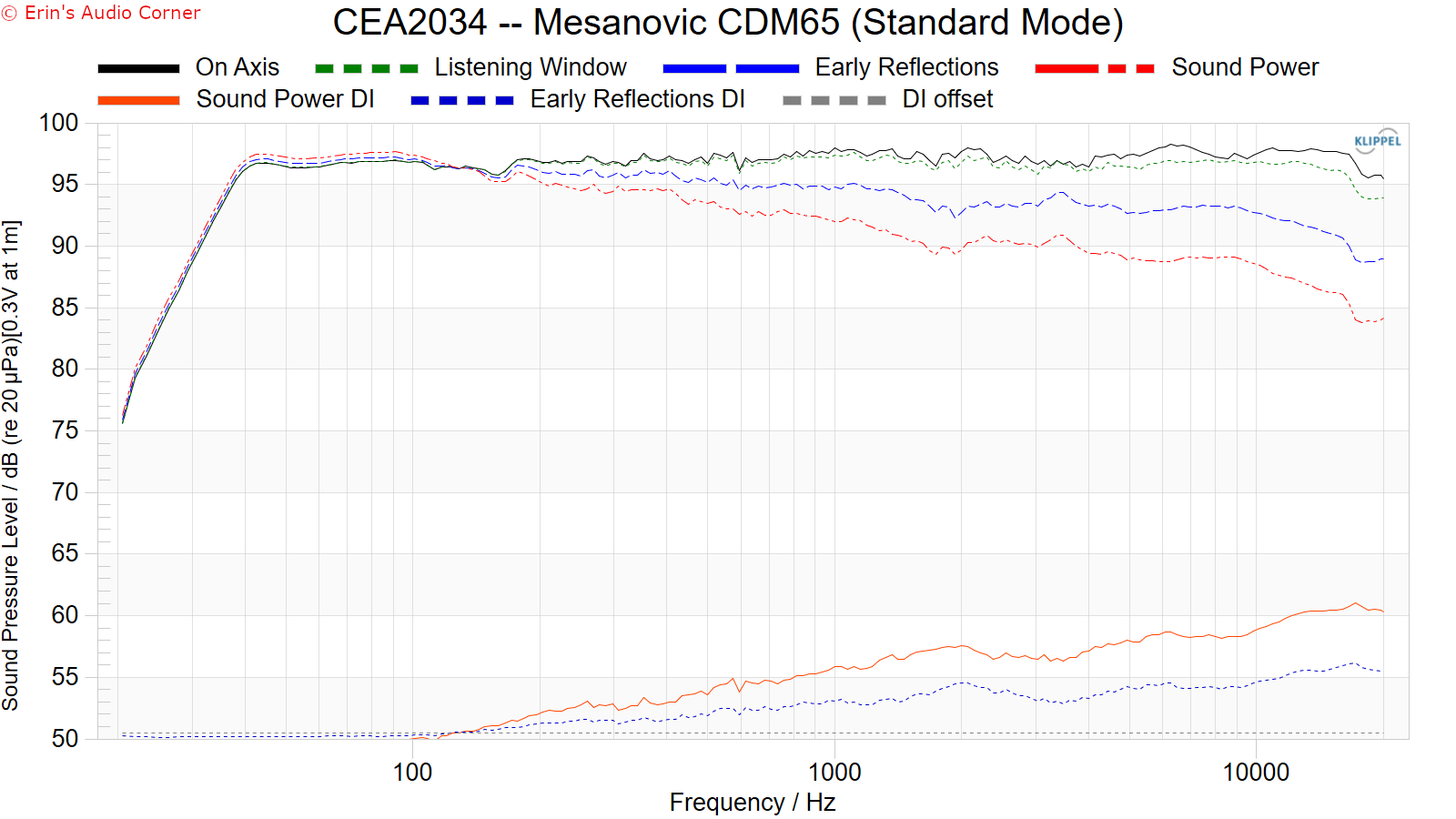
Early Reflections Breakout:
Floor bounce: average of 20º, 30º, 40º down
Ceiling bounce: average of 40º, 50º, 60º up
Front wall bounce: average of 0º, ± 10º, ± 20º, ± 30º horizontal
Side wall bounces: average of ± 40º, ± 50º, ± 60º, ± 70º, ± 80º horizontal
Rear wall bounces: average of 180º, ± 90º horizontal

Estimated In-Room Response:
In theory, with complete 360-degree anechoic data on a loudspeaker and sufficient acoustical and geometrical data on the listening room and its layout it would be possible to estimate with good precision what would be measured by an omnidirectional microphone located in the listening area of that room. By making some simplifying assumptions about the listening space, the data set described above permits a usefully accurate preview of how a given loudspeaker might perform in a typical domestic listening room. Obviously, there are no guarantees, because individual rooms can be acoustically aberrant. Sometimes rooms are excessively reflective (“live”) as happens in certain hot, humid climates, with certain styles of interior décor and in under-furnished rooms. Sometimes rooms are excessively “dead” as in other styles of décor and in some custom home theaters where acoustical treatment has been used excessively. This form of post processing is offered only as an estimate of what might happen in a domestic living space with carpet on the floor and a “normal” amount of seating, drapes and cabinetry.
For these limited circumstances it has been found that a usefully accurate Predicted In-Room (PIR) amplitude response, also known as a “room curve” is obtained by a weighted average consisting of 12 % listening window, 44 % early reflections and 44 % sound power. At very high frequencies errors can creep in because of excessive absorption, microphone directivity, and room geometry. These discrepancies are not considered to be of great importance.


Horizontal Frequency Response (0° to ±90°):

Vertical Frequency Response (0° to ±40°):
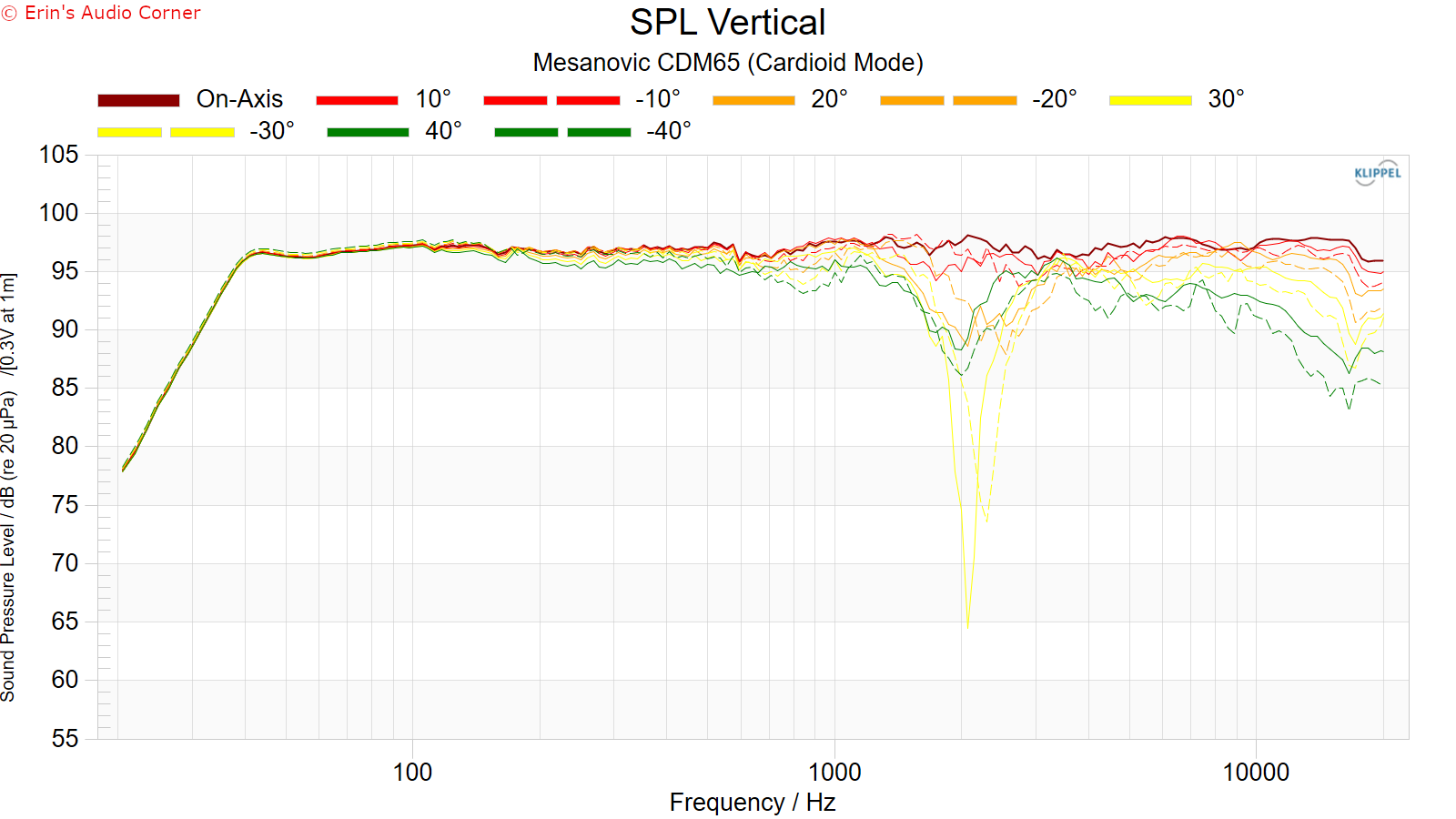
Horizontal Contour Plot (normalized):
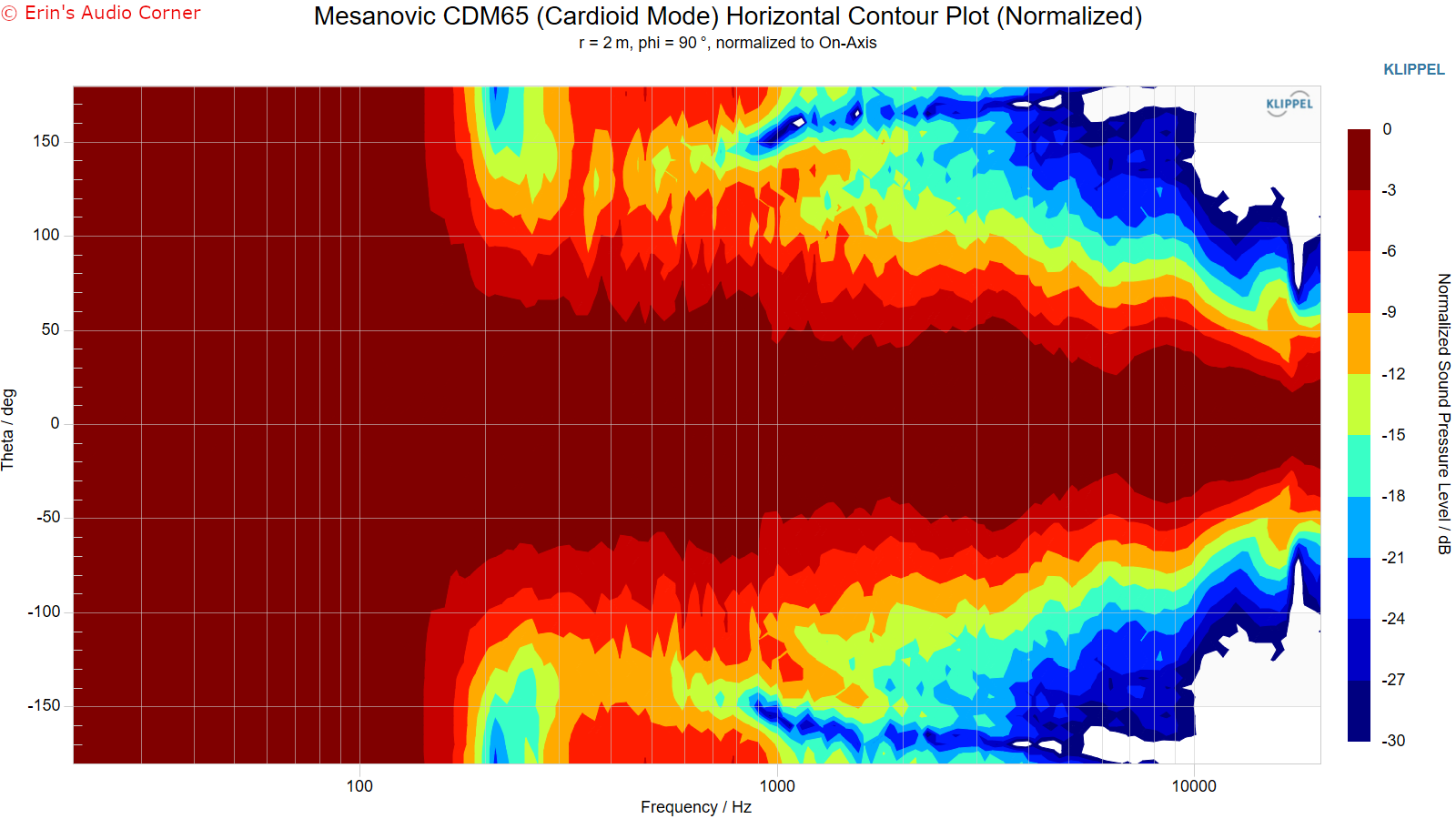
Vertical Contour Plot (normalized):
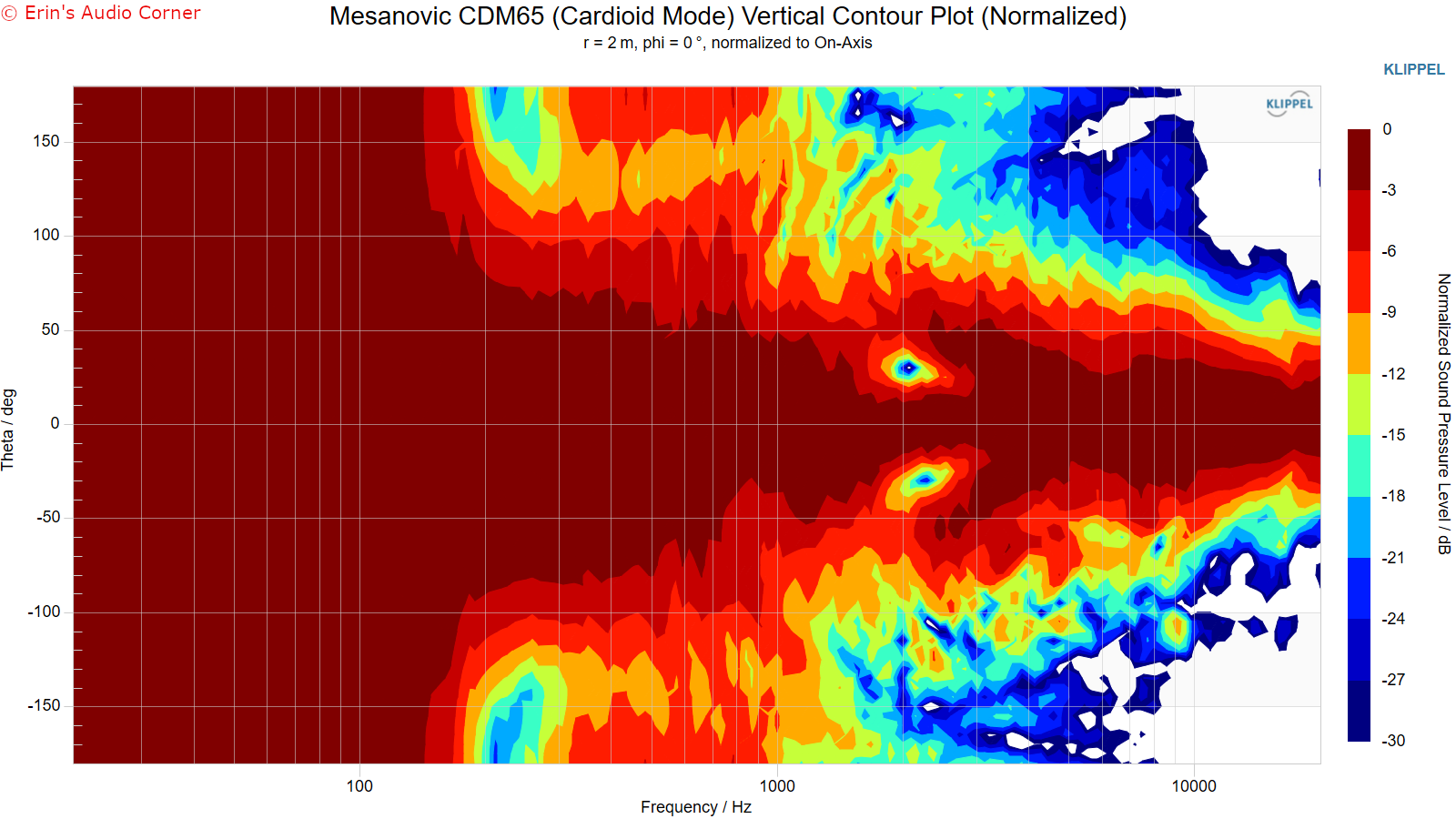
“Globe” Plots
Horizontal Polar (Globe) Plot:
This represents the sound field at 2 meters - above 200Hz - per the legend in the upper left.
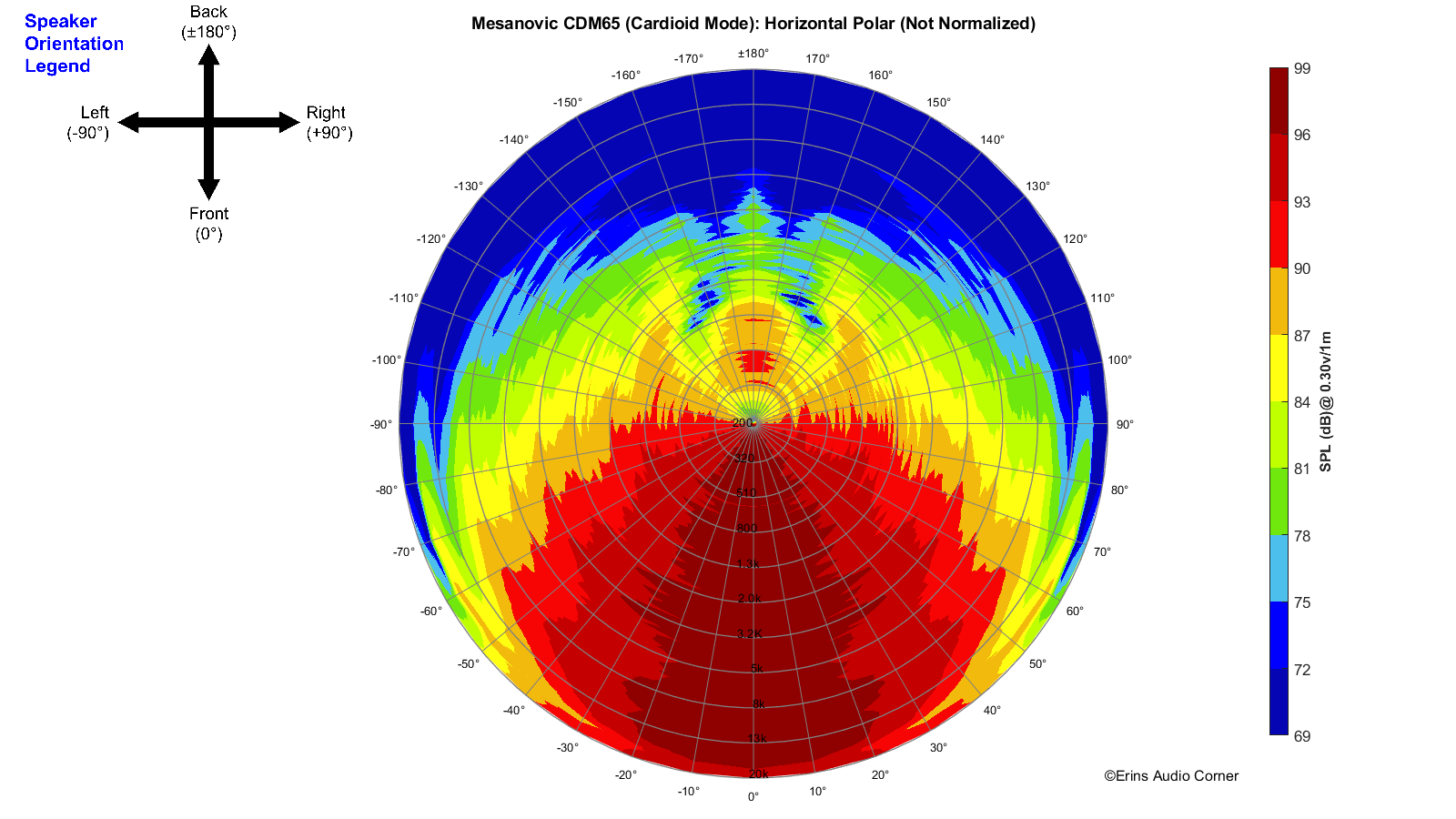
Vertical Polar (Globe) Plot:
This represents the sound field at 2 meters - above 200Hz - per the legend in the upper left.

Additional Measurements
Response Linearity

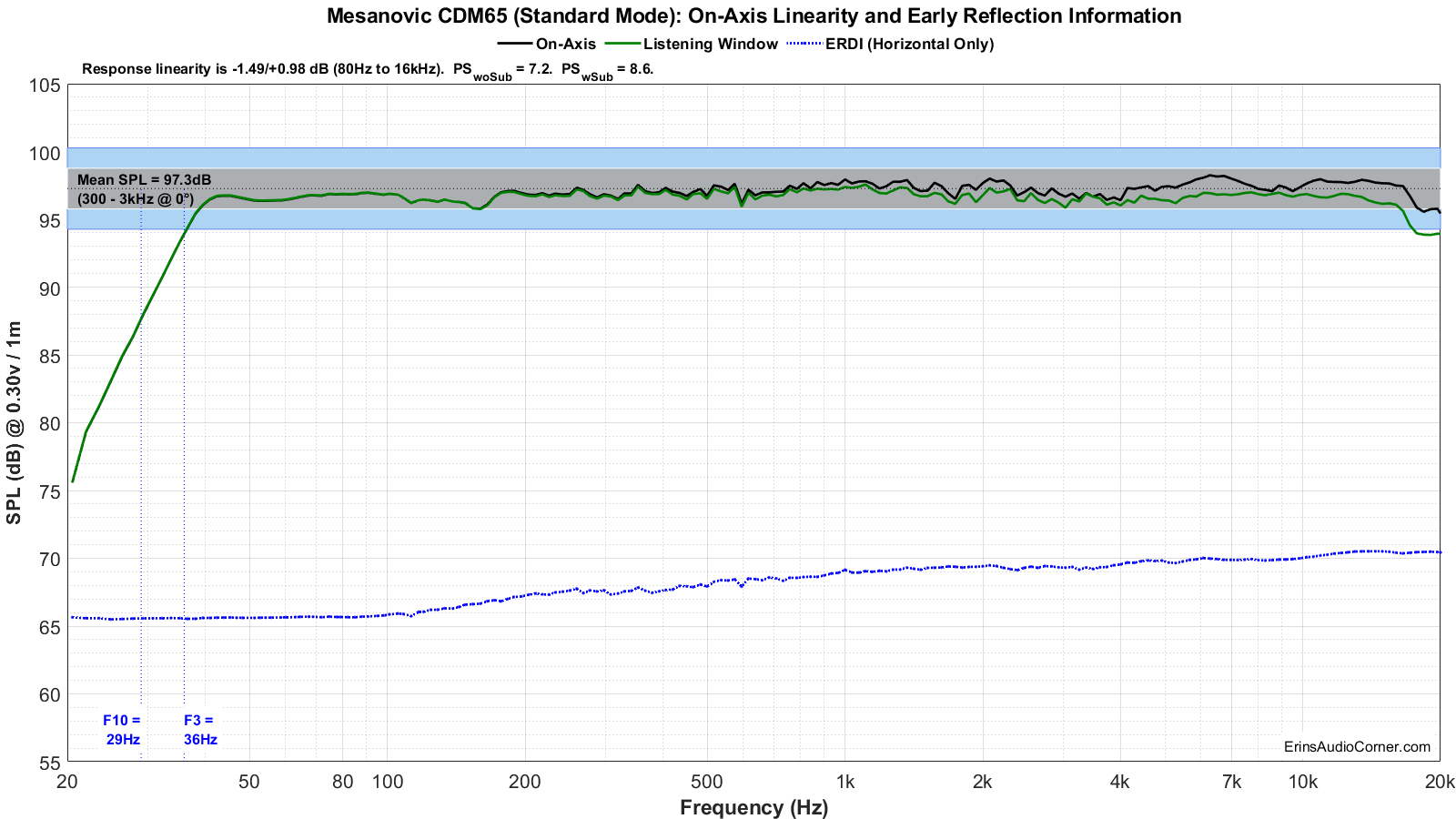
Step Response

Group Delay
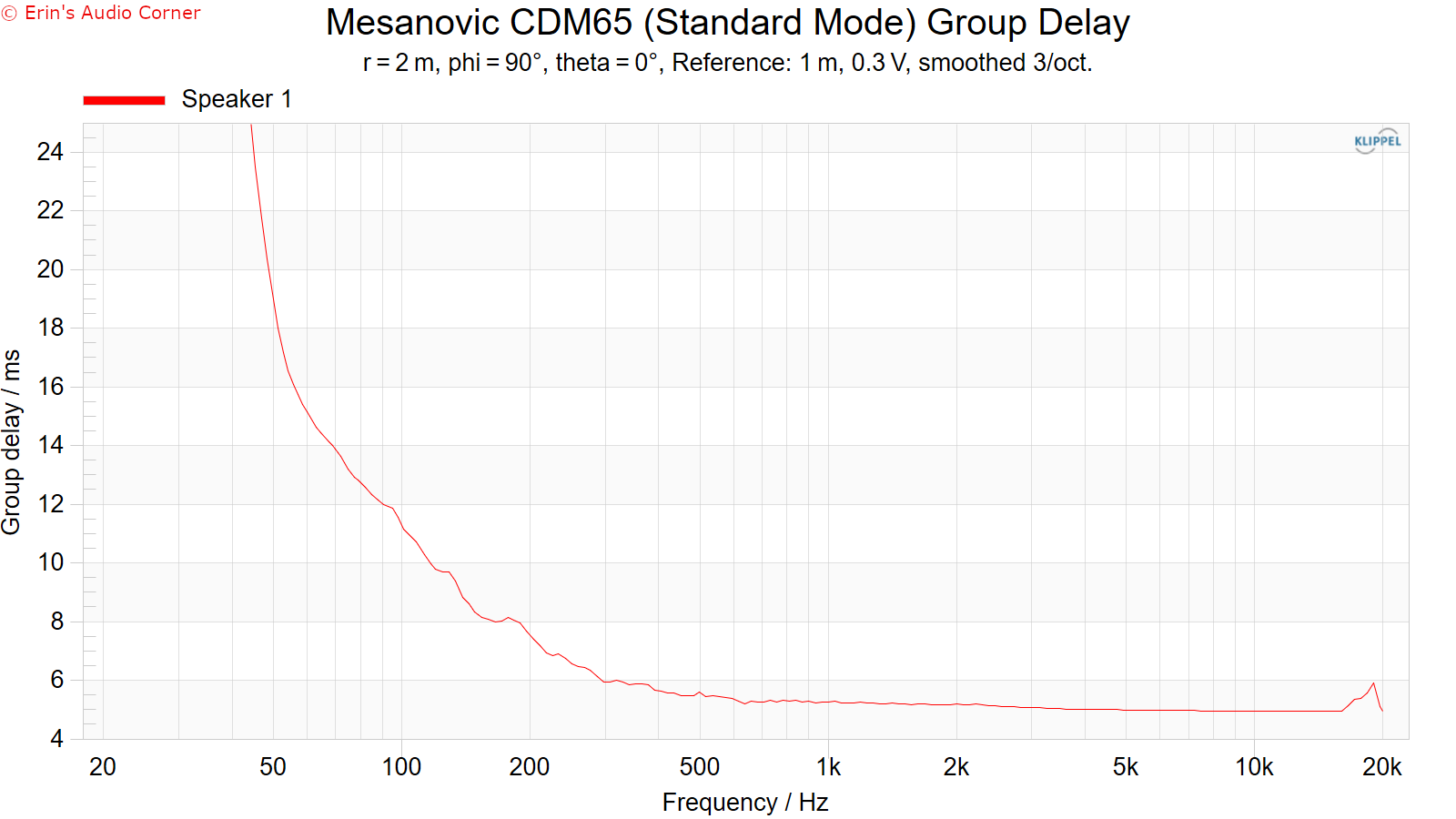
Harmonic Distortion
Harmonic Distortion at 86dB @ 1m:
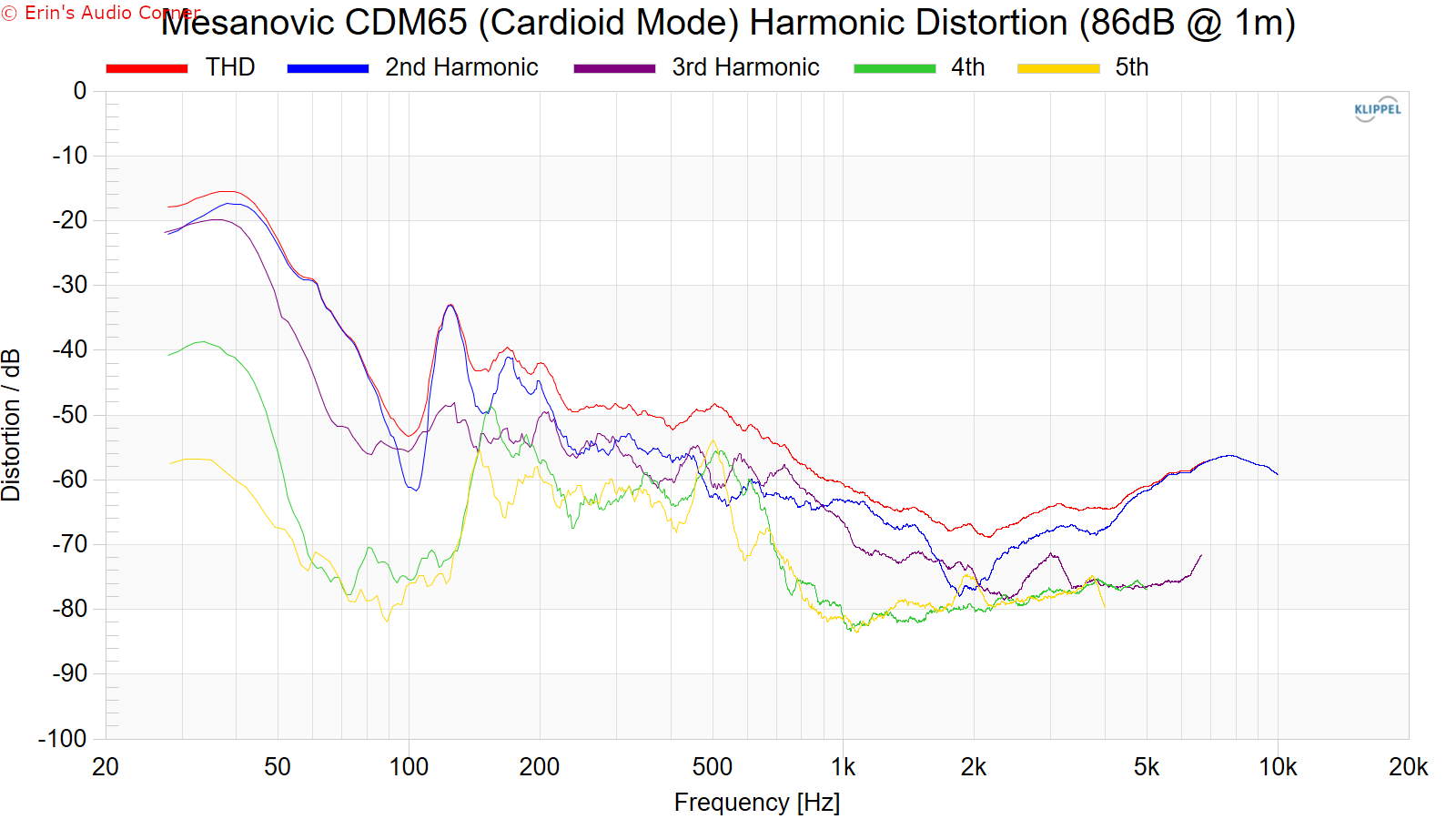
Harmonic Distortion at 96dB @ 1m:

Harmonic Distortion at 86dB @ 1m:
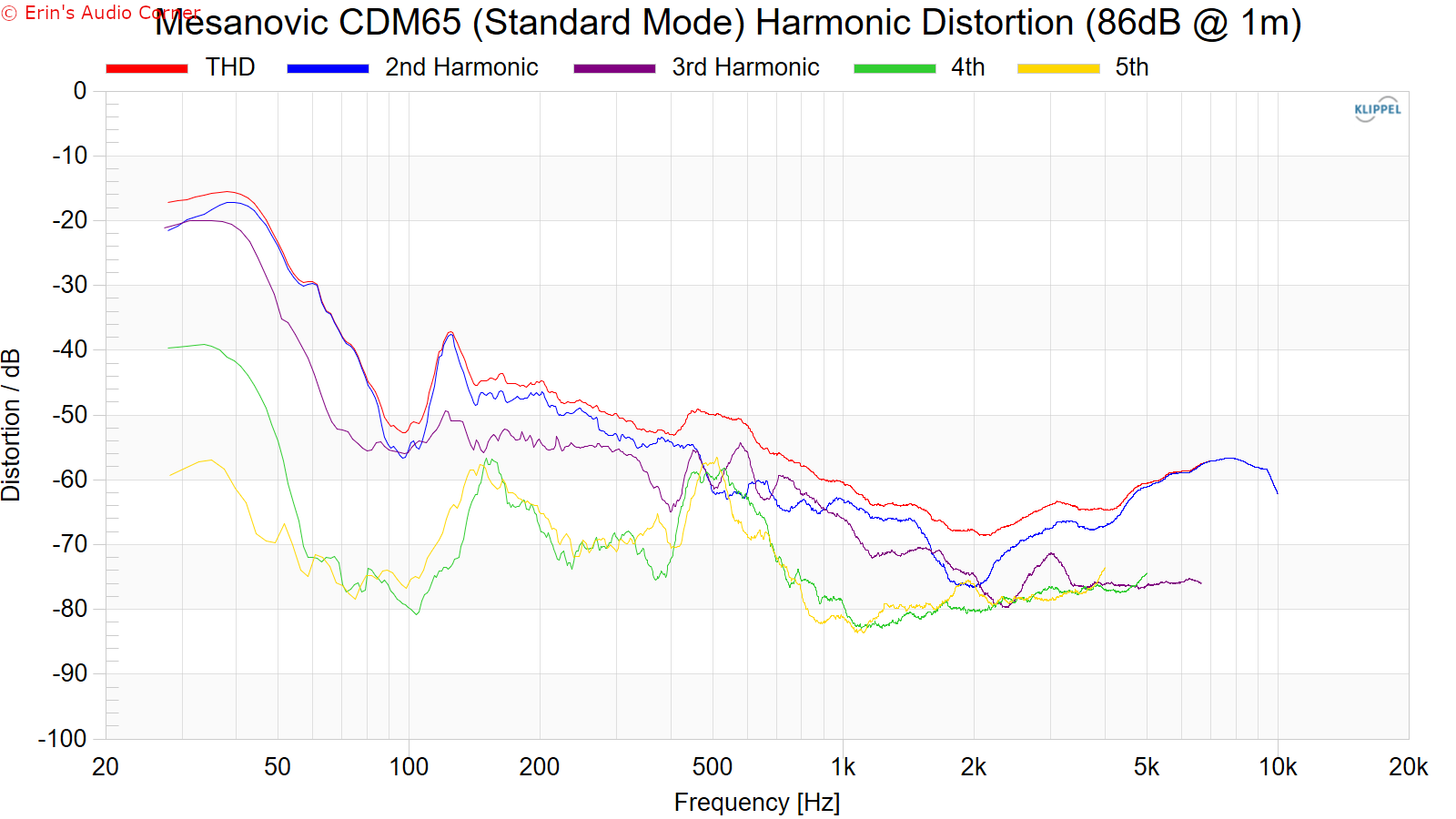
Harmonic Distortion at 96dB @ 1m:
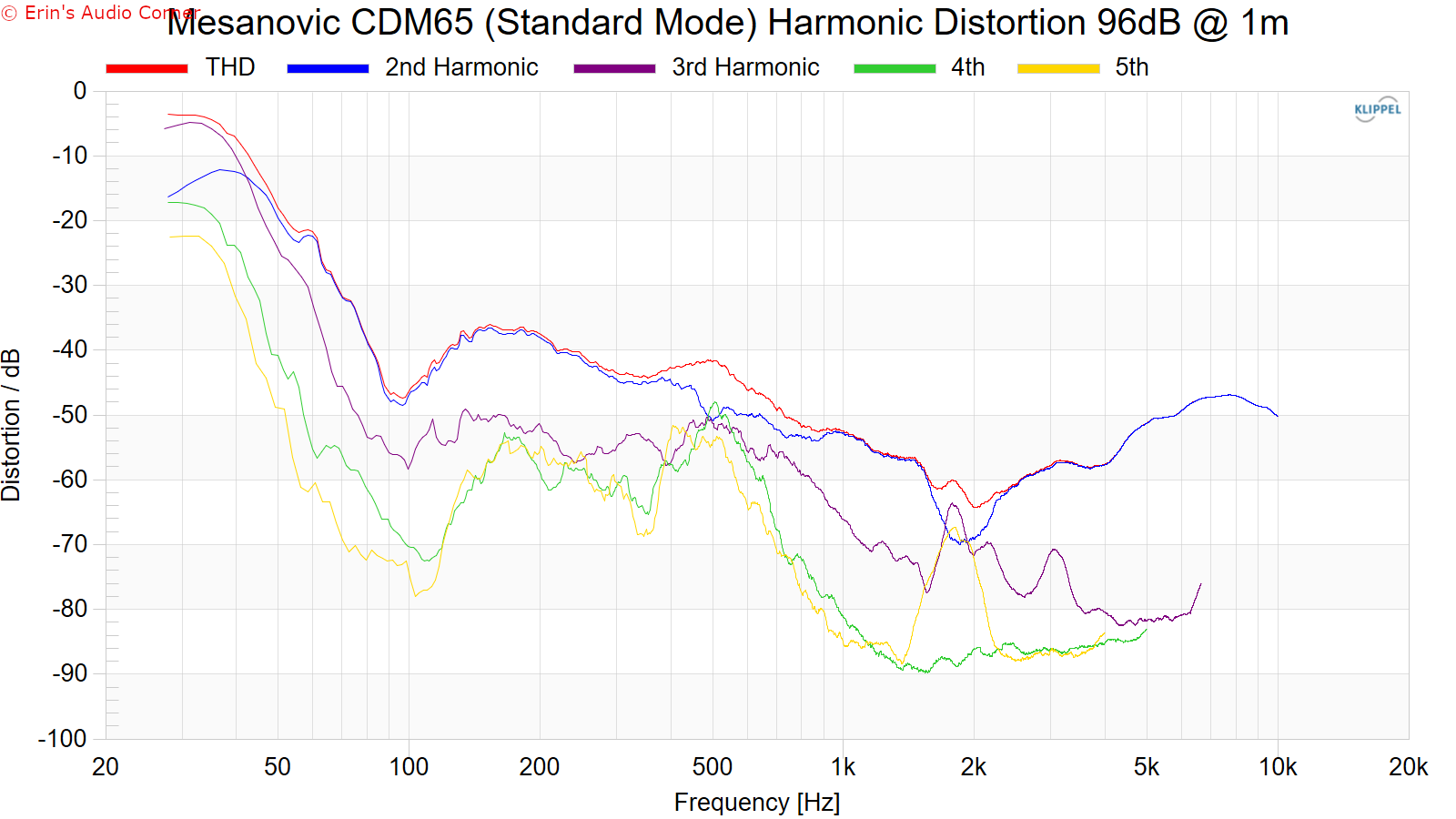
Dynamic Range (Instantaneous Compression Test)
Note: I was informed that Mesanovic has adjusted their limiter so please see their website for their updated test which was done to mimic mine.
The below graphic indicates just how much SPL is lost (compression) or gained (enhancement; usually due to distortion) when the speaker is played at higher output volumes instantly via a 2.7 second logarithmic sine sweep referenced to 76dB at 1 meter. The signals are played consecutively without any additional stimulus applied. Then normalized against the 76dB result.
The tests are conducted in this fashion:
- 76dB at 1 meter (baseline; black)
- 86dB at 1 meter (red)
- 96dB at 1 meter (blue)
- 102dB at 1 meter (purple)
The purpose of this test is to illustrate how much (if at all) the output changes as a speaker’s components temperature increases (i.e., voice coils, crossover components) instantaneously.

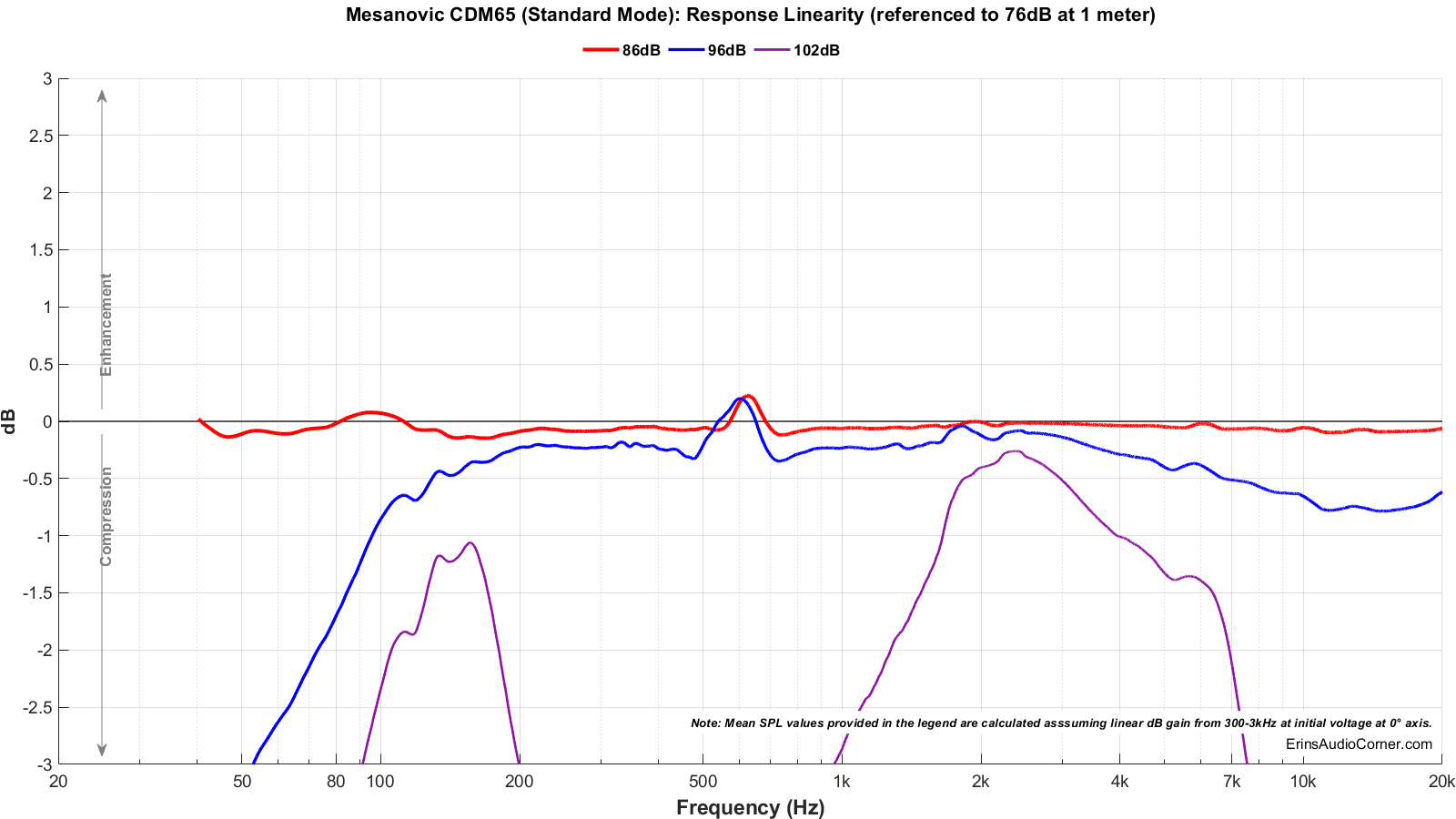
Multitone Distortion
The following tests are conducted at (4) approximate equivalent output volumes: 70/79/87/96dB @ 1 meter. The (4) voltages listed in the legend result in these SPL values.
The test was conducted in (1) manner:
- Full bandwidth (20Hz to 20kHz)
For information on how to read the below data, watch this video:
- Full bandwidth (20Hz to 20kHz)

- Full bandwidth (20Hz to 20kHz)

Parting / Random Thoughts
See video linked above for subjective and objective analysis. But just a couple notes:
- Killer speaker at a real good price. Cardioid mode is a treat to have when you are limited in space and otherwise have to place the speaker near the backwall. Using these speakers in cardioid mode lowers the “boomy”, midrange-heavy sound that placing a speaker near the wall typically results in. What you wind up with a more neutral male and female vocal even when not ideally placed (i.e., typically you’d want to place speakers about 1 meter from the rear wall; you don’t have to worry about that when cardioid mode is engaged on these speakers).
- Excellent linearity from 36Hz to 20kHz with response being about ±1.25dB from 40Hz to 16kHz.
- Excellent horizontal directivity.
- Horizontal radiation is pretty much where I prefer it to be at about ±60° on average.
- Where most waveguide designs are better listened to slightly off-axis, I suggest listening to these on-axis because there is practically no diffraction dip from the waveguide.
- Vertical positioning may be a bit trickier, though, with the window closer to around ±10°, so make sure to sit near tweeter level.
- Output is somewhat limited but Mesanovic has informed me they relaxed their limiter constraints so the limiter won’t kick in so hard in the midrange at the higher output volumes. If used in the near/mid-field then I seriously doubt you’ll have any issues here but do keep this in mind if you are sitting more than a couple meters away as the limiter impacts the response below about 100Hz pretty significantly at far distances/high output.
Overall this is a fantastic speaker that comes ready to rock. In my listening sessions the cardioid mode was a welcome feature to keep midrange bloom down. If you look at the Estimated In-Room Response you can see that the Cardioid mode exhibits a dip around 200-300Hz and the Standard mode shows a more linear response through this region. If one is listening to these speakers where the speakers are placed off the walls then the Standard mode would work best. But if you are listening to these speakers where they are placed near a backwall then that dip fills in naturally from the boundary loading effect and you get a more neutral response. At this price I find this speaker easy to recommend.
Support / Contribute
If you find this review helpful and want to help support the cause that would be AWESOME! There are a few ways you can do so below. Your support helps me pay for new items to test, hardware, miscellaneous items needed for testing, new speakers to review and costs of the site’s server space and bandwidth. Any help is very much appreciated.
Join my Patreon: Become a Patron!
Shopping
If you are shopping at any of the following stores then please consider using my generic affiliate links below to make the purchase through.
Purchases through these links can earn me a small commission - at no additional cost to you - and help me continue to provide the community with free content and reviews. Doesn’t matter if it’s a TV from Crutchfield, budget speakers from Audio Advice or a pair of socks from Amazon, just use the link above before you make your purchase. Thank you!